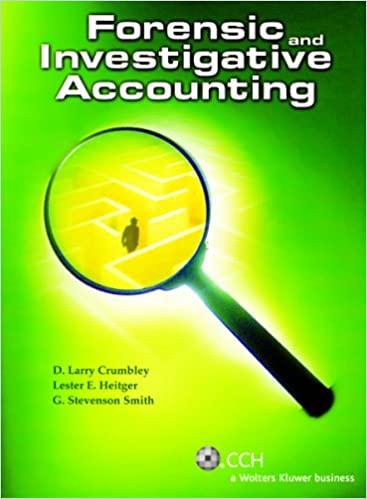Question
Blossom Industrial Products Inc. is a diversified industrial-cleaner processing company. The companys Dargan plant produces two products: a table cleaner and a floor cleaner from
Blossom Industrial Products Inc. is a diversified industrial-cleaner processing company. The companys Dargan plant produces two products: a table cleaner and a floor cleaner from a common set of chemical inputs (CDG). Each week, 855,000 ounces of chemical input are processed at a cost of $207,000 into 570,000 ounces of floor cleaner and 285,000 ounces of table cleaner. The floor cleaner has no market value until it is converted into a polish with the trade name FloorShine. The additional processing costs for this conversion amount to $250,900. FloorShine sells at $18 per 30-ounce bottle. The table cleaner can be sold for $19 per 25-ounce bottle. However, the table cleaner can be converted into two other products by adding 285,000 ounces of another compound (TCP) to the 285,000 ounces of table cleaner. This joint process will yield 285,000 ounces each of table stain remover (TSR) and table polish (TP). The additional processing costs for this process amount to $101,000. Both table products can be sold for $15 per 25-ounce bottle. The company decided not to process the table cleaner into TSR and TP based on the following analysis.
| Process Further | ||||||||||||
|---|---|---|---|---|---|---|---|---|---|---|---|---|
| Table Cleaner | Table Stain Remover (TSR) | Table Polish (TP) | Total | |||||||||
| Production in ounces | 285,000 | 285,000 | 285,000 | |||||||||
| Revenues | $216,600 | $171,000 | $171,000 | $342,000 | ||||||||
| Costs: | ||||||||||||
| CDG costs | 69,000 | * | 51,750 | 51,750 | 103,500 | ** | ||||||
| TCP costs | 0 | 50,500 | 50,500 | 101,000 | ||||||||
| Total costs | 69,000 | 102,250 | 102,250 | 204,500 | ||||||||
| Weekly gross profit | $147,600 | $68,750 | $68,750 | $137,500 | ||||||||
*If table cleaner is not processed further, it is allocated 1/3 of the $207,000 of CDG cost, which is equal to 1/3 of the total physical output. **If table cleaner is processed further, total physical output is 1,140,000 ounces. TSR and TP combined account for 50% of the total physical output and are each allocated 25% of the CDG cost.
(a)
New attempt is in progress. Some of the new entries may impact the last attempt grading.
Your answer is partially correct.
Determine if management made the correct decision to not process the table cleaner further by doing the following. (1) Calculate the companys total weekly gross profit assuming the table cleaner is not processed further.
| Total weekly gross profit | $enter total weekly gross profit in dollars |
(2) Calculate the companys total weekly gross profit assuming the table cleaner is processed further.
| Total weekly gross profit | $enter total weekly gross profit in dollars |
(3) Compare the resulting net incomes and comment on managements decision.
| Management made the select a decision rightwrong decision by choosing to not process table cleaner further. |
eTextbook and Media
Assistance Used
Save for Later
Attempts: 2 of 5 used
Submit Answer
(b)
Using incremental analysis, determine if the table cleaner should be processed further. (Enter negative amounts using either a negative sign preceding the number e.g. -45 or parentheses e.g. (45).)
| Dont Process Table Cleaner Further | Process Table Cleaner Further | Net Income Increase (Decrease) | |||||
|---|---|---|---|---|---|---|---|
| Incremental revenue | $enter Incremental revenue in dollars | $enter Incremental revenue in dollars | $enter Incremental revenue in dollars | ||||
| Incremental costs | enter Incremental costs in dollars | enter Incremental costs in dollars | enter Incremental costs in dollars | ||||
| Totals | $enter a total amount | $enter a total amount | $enter a total amount |
Step by Step Solution
There are 3 Steps involved in it
Step: 1

Get Instant Access to Expert-Tailored Solutions
See step-by-step solutions with expert insights and AI powered tools for academic success
Step: 2

Step: 3

Ace Your Homework with AI
Get the answers you need in no time with our AI-driven, step-by-step assistance
Get Started


